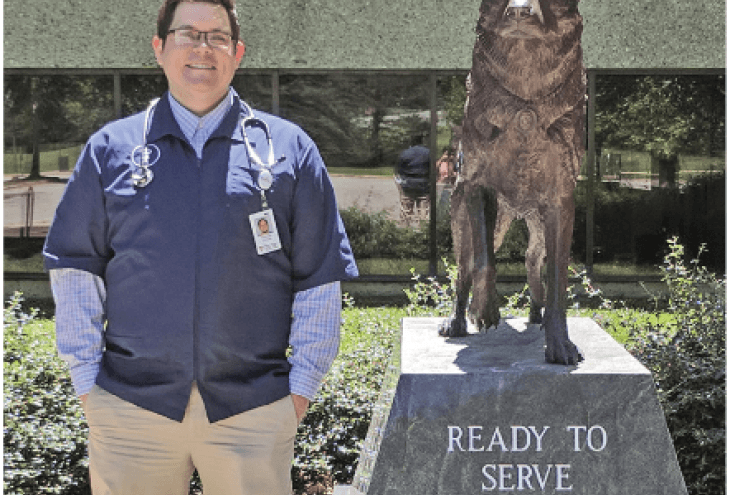He was just looking for a part-time job while he finished up at Mission Viejo High School in Orange County, Calif. It was 2001, and Will Culver had heard that a local veterinary hospital needed kennel assistants. He started out walking dogs, cleaning kennels, and bathing various kinds of animals. When he turned 18, they promoted him to veterinary assistant — and before too long, to veterinary technician, then shift supervisor. “I always loved animals, but that expanded exponentially after I started working at the hospital,” he says. “I was amazed to see all the different, great things you can do with animals and medicine.”
After graduating from high school in 2002, Culver, Cherokee, worked mostly full time at one animal hospital or another. He also took classes at local Saddleback College, but struggled. “I didn’t have a lot of academic direction or support, and I simply didn’t know about some of the resources available,” he observes. Worse, the grades on his transcript didn’t reflect his aptitude for STEM, especially science. “That was pretty demotivating, and my life direction felt pretty stagnant,” he recalls.
Eventually, he realized that something had to shift. Culver met with a guidance counselor to see what his community college credits amounted to, and decided to apply for a transfer to a four-year college. “I knew that I needed — and was ready for — a drastic life change to get back on track,” he explains. With new motivation, he graduated from Saddleback with an associate degree in biology in 2012. The following fall, he enrolled at Humboldt State University.
Humboldt, in Arcata, Calif., was about 700 miles away from home, and it had taken almost a decade to get there. But Culver was just getting started. He decided to major in wildlife with a concentration in conservation biology and applied vertebrate ecology. It was an ambitious agenda — but he wasn’t alone anymore. “The Indian Natural Resources, Science, and Engineering Program at Humboldt reached out to me even before I stepped foot on campus,” he says. “I was almost overwhelmed by all the academic, emotional, and cultural support.”
Part of that support was an introduction to AISES. Culver attended the AISES National Conference in Anchorage, Alaska, in 2012 and began to learn about all kinds of opportunities he didn’t know existed. In 2013, he was selected for a summer Native American and Pacific Islander Research Experience. When he presented his research at the AISES National Conference in Denver later that year, he was awarded first place for his oral presentation and second place for his poster presentation.
“Once I had a circle of support, I completely went for everything,” Culver recalls. He taught a review course in botany, tutored fellow students in STEM subjects, and guided freshmen through orientation as a peer counselor. In 2014, he was awarded a scholarship for the Summer Undergraduate Research Experience program at the University of South Dakota,which meant working side by side with professional researchers. Next, he received an AISES travel scholarship to present his research at the 2014 AISES National Conference in Orlando, Fla.
And he never forgot a meeting he had in 2012 at his first AISES National Conference with Dr. Edward Monroe of the Virginia-Maryland Regional College of Veterinary Medicine (VA-MD Vet Med). “We talked about all the things I could possibly do in veterinary medicine,” he says. “It opened my eyes and led to my aggressively pursuing acceptance into veterinary college.”
In part, that meant earning the grades required. And Culver would not be denied: his academic turnaround was so dramatic that his senior year at Humboldt was fully funded by scholarships and stipends. He applied to VA-MD Vet Med, interviewed, and was accepted. Since graduating from Humboldt in 2015, he’s been
I want to help Native youth interested in veterinary school. I would like to guide them through the same kinds of challenges I faced, and help them avoid some pitfalls.
on the VA-MD Vet Med Public/ Corporate track, which covers some of the less conventional aspects of veterinary practice — including public health, disease control, and food safety. In addition, he now serves on his school’s Diversity Committee — along with his mentor, Dr. Monroe.
As he begins his third year of study, Culver is on track for graduating in 2019 with doctor of veterinary medicine and master of public health degrees. Longer term, he hopes to open a wildlife sanctuary with his brother, who’s now pursuing the same degree Culver earned at Humboldt. Shorter term, Culver plans to pursue a direct commission in the U.S. Army Veterinary Corps, where veterinarians do everything from treating military animals to inspecting food and carrying out health and humanitarian missions. Already this past summer, he participated in a veterinary externship at the U.S. Army Medical Research Institute of Infectious Diseases.
And Culver has another goal. “I want to help Native youth interested in veterinary school,” he says. “I would like to guide them through the same kinds of challenges I faced, and help them avoid some pitfalls. There’s a relatively low percentage of Native American vets and not many pathway programs, compared to human medicine. It gets so much easier when you have someone who’s been down a similar path.”
A support network has been an important factor in Culver’s success so far, and he encourages other students to find their own anchor. “It’s a little wild to look back at how it all came together, from a part-time job to a career,” he adds. “I don’t think anyone gets to this level of education without an immense base of support. I want students out there to know that there’s so much they can accomplish. And there are people who will be there to help you succeed.”











